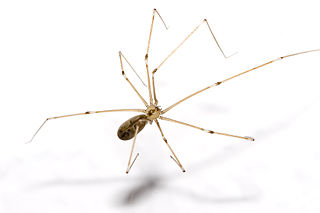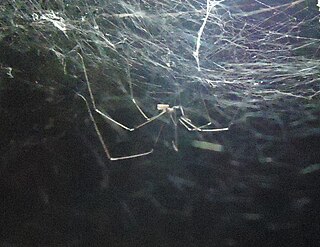
The Pholcidae are a family of araneomorph spiders. The family contains over 1,800 pholcids, including those commonly known as the marbled cellar spider , daddy long-legs spider, granddaddy long-legs spider, carpenter spider, daddy long-legger, vibrating spider, gyrating spider, long daddy, and skull spider. The family, first described by Carl Ludwig Koch in 1850, is divided into 94 genera.

Euryattus is a genus of spiders in the family Salticidae.
Pacullidae is a family of araneomorph spiders first described by Eugène Simon in 1894. It was merged into Tetrablemmidae in 1958, then raised back to family status after a large phylogenetic study in 2017.

Crossopriza lyoni is a widespread species of cellar spiders that prefer to live in or around human structures. They are commonly known as tailed cellar spiders, tailed daddy longlegs spiders, and sometimes box spiders. They all possess extremely long fragile legs that can reach up to 6 cm (2.4 in) long and a body length of that ranges from 2.5 to 7 mm. Their abdomens are distinctly squarish when viewed from the side and their carapace is more or less circular when viewed from above. They also possess two kinds of sound-producing organs and have six eyes.
Micropholcus is a genus of cellar spiders that was first described by Christa Laetitia Deeleman-Reinhold & J. D. Prinsen in 1987.
Utivarachna is a genus of Asian araneomorph spiders in the family Trachelidae first described by Kyukichi Kishida in 1940. It was largely ignored until Christa L. Deeleman-Reinhold revised the sac and ground spiders in 2001, transferring some species from Trachelas and adding several new ones. The genus was further expanded in 2014 and 2015.
Nusatidia is a genus of Asian sac spiders first described by Christa L. Deeleman-Reinhold in 2001.
Koppe is a genus of liocranid sac spiders first described by Christa L. Deeleman-Reinhold in 2001.
Oedignatha is a genus of Asian spiders first described by Tamerlan Thorell in 1881 as a genus of corrinid sac spiders, and moved to Liocranidae in 2014.
Malamatidia is a genus of Southeast Asian sac spiders first described by Christa L. Deeleman-Reinhold in 2001.
Pristidia is a genus of Asian sac spiders first described by Christa L. Deeleman-Reinhold in 2001.
Pteroneta is a genus of sac spiders first described by Christa L. Deeleman-Reinhold in 2001.
Castoponera is a genus of Southeast Asian corinnid sac spiders first described by Christa L. Deeleman-Reinhold in 2001.
Echinax is a genus of Asian and African corinnid sac spiders first described by Christa L. Deeleman-Reinhold in 2001.
Medmassa is a genus of corinnid sac spiders first described by Eugène Simon in 1887 under the name "Megaera", later renamed because "Megaera" was already in use as a synonym of the reptile genus Trimeresurus.
Sesieutes is a genus of Asian liocranid sac spiders first described by Eugène Simon in 1897. It was briefly transferred to the Corinnidae in 2013, but was returned a year later due to its similarity and relation to Phrurolithus.
Pehrforsskalia is a genus of cellar spiders that was first described by Christa Laetitia Deeleman-Reinhold & A. van Harten in 2001. As of June 2019 it contains only three species, found only in Africa, Israel, and Yemen: P. bilene, P. conopyga, and P. shambaa.
Christa Laetitia Deeleman-Reinhold is a Dutch arachnologist. She specializes in spiders from Southeast Asia and Southern Europe, particularly cave-dwelling and tropical spiders. She donated a collection of about 25,000 Southeast Asian spiders, the largest collection of Southeast Asian spiders in existence, to the Naturalis Biodiversity Center in Leiden. In addition to numerous articles, she has written the book Forest Spiders of South East Asia (2001).
Apokayana is a genus of Malaysian and Indonesian cellar spiders first described by B. A. Huber, J. Eberle & D. Dimitrov in 2018.
Nipisa is a genus of southeastern Asian cellar spiders first described by B. A. Huber, J. Eberle & D. Dimitrov in 2018.





